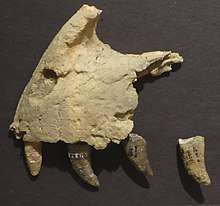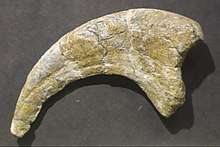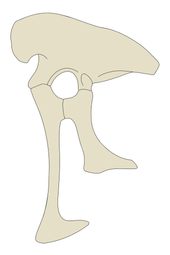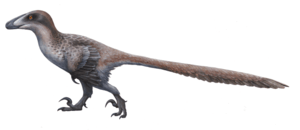Utahraptor
Utahraptor (meaning Utah's predator) is a genus of large dromaeosaurid theropod dinosaur that lived in North America during the Early Cretaceous period. It was a heavy-built, ground-dwelling, bipedal carnivore. It contains a single species, Utahraptor ostrommaysi, which is the largest-known member of the family Dromaeosauridae.[1]
| Utahraptor | |
|---|---|
 | |
| Reconstructed skeleton in BYU Museum of Paleontology | |
| Scientific classification | |
| Kingdom: | Animalia |
| Phylum: | Chordata |
| Clade: | Dinosauria |
| Clade: | Saurischia |
| Clade: | Theropoda |
| Family: | †Dromaeosauridae |
| Subfamily: | †Dromaeosaurinae |
| Genus: | †Utahraptor Kirkland, Gaston & Burge, 1993 |
| Type species | |
| †Utahraptor ostrommaysi Kirkland et al, 1993 | |
In 2018, it was proposed that Utahraptor be the Utah state dinosaur, an act that was approved by the Senate.[2] Initially Utahraptor would have replaced another dinosaur, Allosaurus, as the state's official fossil, but it was decided that Utahraptor would be another symbol of the state.[3]
Discovery and naming

The first specimens of Utahraptor were found in 1975 by Jim Jensen in the Dalton Wells Quarry in east-central Utah, near the town of Moab, but did not receive much attention. After a find of a large foot-claw by Carl Limoni in October 1991, James Kirkland, Robert Gaston, and Donald Burge uncovered further remains of Utahraptor in 1991 in the Gaston Quarry in Grand County, Utah, within the Yellow Cat and Poison Strip members of the Cedar Mountain Formation.[1] The holotype, CEU 184v.86, is currently housed at the College of Eastern Utah Prehistoric Museum, although Brigham Young University, the depository of Jensen's finds, currently houses the largest collection of Utahraptor fossils.
The type species (and only known species of Utahraptor), Utahraptor ostrommaysi, was named by Kirkland, Gaston, and Burge in June 1993. The genus name Utahraptor is in reference to Utah, where the remains were found. The specific name, ostrommaysi, is in honour to John Ostrom for his investigations on Deinonychus and its bird relationships, and Chris Mays, who helped in the research of Utahraptor by founding Dinamation.[1] Earlier, it had been intended to name the species "Utahraptor spielbergi" after film director Steven Spielberg, in exchange for funding paleontological research, but no agreement could be reached on the amount of financial assistance.[4]
Additional findings

In 2001, Kirkland et al, pursued a graduate student's discovery of a bone protruding from a 9-ton fossil block of sandstone in eastern Utah. It was determined to contain the bones of at least seven individuals, including an adult measuring about 4.8 m (16 ft), four juveniles and a hatchling about 1 m (3.3 ft) long. Also fossilized with the predators are the remains of at least one possible iguanodont herbivore.[5]
Kirkland speculated that the Utahraptor pack attempted to scavenge carrion or attack helpless prey mired in quicksand, and were themselves mired in the attempt to attack the herbivore. Similar sites such as the Cleveland-Lloyd Quarry and California's La Brea Tar Pits house such predator traps. Examination of the fossils are ongoing after a decade of excavation, but if Kirkland is correct, it may be one of the best preserved predator traps ever discovered. The fossils may further reveal aspects into the behavior of Utahraptor, such as whether it might have hunted in groups like Deinonychus is believed to have done.[5] Whether all the Utahraptor individuals were mired simultaneously or were drawn in, one-by-one, is unclear, as work is currently slowed on the specimens. More concrete answers may yet come to light once crowdfunding efforts to employ professional excavator, Utahraptor Project leader Scott Madsen, are completed.[5]
Description

The holotype of Utahraptor, CEU 184v.86 consists of a second pedal ungual, with potentially assigned elements from other specimens: pedal ungual CEU 184v.294, tibia CEU 184v.260 and premaxilla CEU 184v.400. These elements have huge proportions compared to other dromaeosaurids, suggesting an animal about twice the length of Deinonychus or, surpassing it in a 100%.[1] Like other dromaeosaurids, Utahraptor had large curved claws on their second toes. The second pedal ungual is preserved at 22 cm (8.7 in) in length and is estimated to reach 24 cm (9.4 in) restored.[1]
The largest described U. ostrommaysi specimen (BYUVP 15465, referred by Erickson et al. 2009[6]) is estimated to have reached up to 7 m (23 ft) long and somewhat less than 500 kg (1,100 lb) in weight, comparable to a polar bear in weight.[1] In 2012, the paleontologist Thomas R. Holtz Jr. estimated its weight around 227 to 454 kg (500.4 to 1,000.9 lb), comparable to a grizzly bear.[7] However, the 2001 Kirkland discovery indicates the species may be far heavier than previously estimated.[5] In 2016 Rubén Molina-Pérez and Asier Larramendi estimated the largest specimen (BYU 15465) at 4.65 m (15.3 ft) long, 1.5 m (4.9 ft) tall at the hips and 280 kg (620 lb).[8]

For instance, some elements were wrongly referred to the genus; the lacrimal bone of the specimen CEU 184v.83 turned out to be a postorbital from the ankylosaur Gastonia. Britt et al. also suggested that the previously identified manual unguals of the specimens CEU 184v.294, BYU 9438 and BYU 13068 are indeed pedal unguals.[9] This suggestion was confirmed by Senter in 2007.[10]
According to Kirkland et al. Utahraptor can be recognised by the following autapomorphies:[1] Claws on hand more specialized as cutting blades than in other Dromaeosaurids- A lacrimal bone has distinctly parallel mesial and outer sides, giving it an elongate subrectangular appearance in top view. Premaxilla has base of nasal opening parallel to premaxillary tooth row. In the revised diagnosis conducted by Turner et al. in 2012, Utahraptor differs from other Dromaeosaurids in:[11] Elongate nasal process of premaxilla. Distal end of metatarsal III smooth, not ginglymoid. L-shaped quadratojugal without posterior process. Well developed notch present between lesser trochanter and greater trochanter. Dorsal vertebrae lack pleurocoels.

Although feathers have never been found in association with Utahraptor specimens, there is strong phylogenetic evidence suggesting that all dromaeosaurids possessed them. The genus Microraptor is one of the oldest-known dromaeosaurids, and is phylogenetically more primitive than Utahraptor.[12] Since Microraptor and other dromaeosaurids possessed feathers, it is reasonable to assume that this trait was present in all of Dromaeosauridae. Feathers were very unlikely to have evolved more than once, so assuming that any given dromaeosaurid, such as Utahraptor, lacked feathers would require positive evidence that they did not have them.[13] So far, there is nothing to suggest that feathers were lost in larger, more derived species of dromaeosaurs.[14] The presence of quill knobs in Dakotaraptor evidenced that even larger dromaeosaurids had feathers.[15]
Classification
Utahraptor is a member of the family Dromaeosauridae, a clade of theropod dinosaurs commonly known as "raptors". Utahraptor is the largest genus in the family, and belongs to the same clade as some famous dinosaurs such as Velociraptor, Deinonychus or Dromaeosaurus. It was is classified in the subfamily Dromaeosaurinae, which is found in the clade Eudromaeosauria.[1]
In 2015, Utahraptor was found to be closely related to the smaller Dromaeosaurus and the giant Mongolian and North American dromaeosaurid genera Achillobator and Dakotaraptor:[15]


| Eudromaeosauria |
| ||||||||||||||||||||||||||||||||||||||||||
Below is a cladistic analysis conducted by Cau et al. in 2017[16]
| Eudromaeosauria |
| |||||||||||||||||||||||||||||||||||||||||||||||||||||||||||||||
Paleobiology
Kirkland et al. noted that given the huge size of Utahraptor, it was not fast as Deinonychus or Velociraptor, instead, it would have had a similar speed to the contemporary iguanodonts, and being faster than fellow sauropods. Additionally, the thickness of the tibia indicates that the animal had a significant leg force in order to kill prey.[1]
It was also suggested that dromaeosaurids such as Velociraptor and Deinonychus, relied on their hand claws to handle prey and retain balance while kicking it, contrary to this, Utahraptor with a much greater weight, may have been able to deliver kicks without the risk of losing balance, freeing the hands and using them to dispatch prey.[1] According to paleontologist Gregory S. Paul, Utahraptor was not particularly fast and would have been an ambush hunter that preyed on large dinosaurs such as the contemporary iguanodonts and therizinosaurs it shared its environment with. Its robust build and large sickle claw indicates it was well suited to hunting such prey. Like other dromaeosaurine dromaeosaurids, it may have also relied heavily on its jaws to dispatch prey—more so than other types of dromaeosaurids, such as velociraptorines.[17] In a 2001 study conducted by Bruce Rothschild and other paleontologists, two foot bones referred to Utahraptor were examined for signs of stress fracture, but none were found.[18]
Paleoecology
Utahraptor lived in the lower part of the Cedar Mountain Formation, a bed known as the Yellow Cat Member. According to the authors of its description, Utahraptor had an important ecological role as a major carnivore of the paleofauna of the present-day Arks region during the Early Cretaceous, and could probably attack prey larger than itself. Group hunting of individuals of at least 3.5 m (11 ft) and 70 kg (150 lb), if proven, could have killed 8 m (26 ft) prey of a weight of 1 to 2 t (2,204.6 to 4,409.2 lb). Additionally, sauropods ranging between 20 m (66 ft) may have been an important part of its diet.[1] The paleontologist Thomas R. Holtz estimated that Utahraptor existed between 130 million and 125 million years ago.[7] In multiple occasions, the Yellow Cat Member has been dated to Barremian-Aptian ages. Sames and Schudack 2010 proposed a reassignment of the estimated age, compromising Berriasian to Valanginian stages, however, this interpretation wasn't followed by most authors.[19] Using advanced methods of radiometric and palynological dating, Joeckel et al. 2019 concluded that the Yellow Cat Member is indeed older that previous estimations. The deposition occurred between 139 ± 1.3 million to 134.6 ± 1.7 million years ago, or, Berriasian to Late Valanginian stages. Based on the presence of new palynoflora, Middle Berriasian–Early Hauterivian ages were provisionally assigned.[20]
Environmental flora
Utahraptor was unearthed from the Yellow Cat Member, which during the Berriasian to Late Valanginian was a semiarid area with floodplain prairies, riverine forests, and open woodlands predominated by conifers (Pinophyta), ferns (Polypodiopsida), hornworts (Anthocerotophyta) and other vascular plants.[20] During the description of Mierasaurus, it was interpreted that there was also a waterlogged bog-like environment.[21] There is believed to have been a short wet season. This is supported by the presence of charred spores and other carbonized plant debris in the pollen maceral that indicate the occurrence of ancient wildfires ignited during periods of low precipitation.[17][20]
Contemporaneous fauna

Paleofauna that were contemporaneous with the dromaeosaurid in the Upper Yellow Cat Member included numerous dinosaurs, such as the iguanodonts Hippodraco and Cedrorestes, the other theropods Martharaptor and Nedcolbertia, the nodosaurid Gastonia, and the sauropods Cedarosaurus and Moabosaurus.[21][22][23] The only known mammal from the Upper Yellow Cat Member is Cifelliodon.[24]
Other non-dinosaur taxa known from the Member include the fish Ceratodus and Semionotus, the turtles Glyptops and Trinitichelys, Aquatilavipes (fossilized bird tracks), the rhynchocephalian Toxolophosaurus, and the indeterminate remains of hybodontid and polyacrodontid sharks.[22]
Additional paleofauna was recovered, most of it being unnamed and/or indeterminate, including an isolated Mesoeucrocodylian skull that measures 20 cm (7.9 in) in length.[22] A Neochoristodere unearthed from the Upper Yellow Cat Member, represented by a partial left femur,[25] shows that aquatic paleofauna was present and diverse during the Early Cretaceous of the Cedar Mountain Formation.[22] A large sail-backed iguanodont represented by large vertebrae and fragmentary remains.[26] An indeterminate eudromaeosaur known from a caudal vertebra and fragmented tail (UMNH VP 20209) was also present.[27]
Cultural significance
Raptor Red was published in 1995, and features the fictionalized story of a female Utahraptor. Written by paleontologist Robert T. Bakker, it was positively regarded by mainstream reviewers, though updates to the science have rendered some of the story line facts presented untrue and the paleontology community was critical of fossil record inaccuracies.[28][29] Bakker's anthropomorphosis of the titular Red was particularly praised.[30][31][32]
See also
| Wikimedia Commons has media related to Utahraptor. |
| Wikinews has related news: Stolen Utahraptor recovered in Australian Capital Territory |
- Timeline of dromaeosaurid research
- Cedar Mountain Formation
- James Ian Kirkland
- 1993 in paleontology
- BYU Museum of Paleontology
- USU Eastern Prehistoric Museum
External links
References
- Kirkland, J. I.; Burge, D.; Gaston, R. (1993). "A large dromaeosaurid (Theropoda) from the Lower Cretaceous of Eastern Utah". Hunteria. 2 (10): 1–16.
- Nicole Nixon (February 12, 2018). "Senate Gives Utahraptor A Roar Of Approval". Retrieved February 13, 2018.
- Lisa Riley Roche (February 12, 2018). "Senate approves bill making Utahraptor state dinosaur". Retrieved February 18, 2018.
- Adams, Brooke (June 15, 1993). "Director Loses Utahraptor Name Game". Deseret News. Retrieved April 15, 2017.
- Kirkland, J.I.; Simpson, E.L.; DeBlieux, D.D.; Madsen, S.K.; Bogner, E.; Tibert, N.E. (September 1, 2016). "Depositional constraints on the Lower Cretaceous stikes quarry dinosaur site: Upper yellow cat member, cedar mountain formation, Utah". PALAIOS. 31 (9): 421–439. doi:10.2110/palo.2016.041.
- Erickson, G. M.; Rauhut, O. W. M.; Zhou, Z.; Turner, A. H.; Inouye, B. D.; Hu, D.; Norell, M. A. (2009). "Was Dinosaurian Physiology Inherited by Birds? Reconciling Slow Growth in Archaeopteryx". PLoS ONE. 4 (10): e7390. doi:10.1371/journal.pone.0007390. PMC 2756958. PMID 19816582.
- Holtz, T. R.; Rey, L. V. (2007). Dinosaurs: The Most Complete, Up-to-Date Encyclopedia for Dinosaur Lovers of All Ages. Random House. Supplementary Information 2012 Weight Information
- Molina-Peréz & Larramendi (2016). Récords y curiosidades de los dinosaurios Terópodos y otros dinosauromorfos. Barcelona, Spain: Larousse. p. 275. ISBN 9780565094973.
- Britt, B. B.; Chure, D. J.; Stadtman, K. L.; Madsen, J. H.; Scheetz, R. D.; Burge, D. L. (2001). "New osteological data and the affinities of Utahraptor from the Cedar Mountain Fm. (Early Cretaceous) of Utah". Journal of Vertebrate Paleontology. 21 (3): 36A.
- Senter, P. (2007). "A method for distinguishing dromaeosaurid manual unguals from pedal "sickle claws"". Bulletin of the Gunma Museum of Natural History (11): 1–6. ISSN 1342-4092.
- Turner, A. H.; Makovicky, P. J.; Norell, M. A. (2012). "A Review of Dromaeosaurid Systematics and Paravian Phylogeny". Bulletin of the American Museum of Natural History. 371 (371): 1–206. doi:10.1206/748.1. hdl:2246/6352.
- Xu, X.; Zhou, Z.; Wang, X.; Kuang, X.; Zhang, F.; Du, X. (2003). "Four-winged dinosaurs from China". Nature. 421 (6921): 335–340. doi:10.1038/nature01342. PMID 12540892.
- Prum, R.; Brush, A.H. (2002). "The evolutionary origin and diversification of feathers". The Quarterly Review of Biology. 77 (3): 261–295. doi:10.1086/341993. PMID 12365352.
- Turner, AH; Makovicky, PJ; Norell, MA (2007). "Feather quill knobs in the dinosaur Velociraptor". Science. 317 (5845): 1721. doi:10.1126/science.1145076. PMID 17885130.
- DePalma, Robert A.; Burnham, David A.; Martin, Larry D.; Larson, Peter L.; Bakker, Robert T. (2015). "The First Giant Raptor (Theropoda: Dromaeosauridae) from the Hell Creek Formation". Paleontological Contributions (14). doi:10.17161/paleo.1808.18764.
- Cau, A.; Beyrand, V.; Voeten, D.; Fernandez, V.; Tafforeau, P.; Stein, K.; Barsbold, R.; Tsogtbaatar, K.; Currie, P.; Godrfroit, P. (December 6, 2017). "Synchrotron scanning reveals amphibious ecomorphology in a new clade of bird-like dinosaurs". Nature. 552 (7685): 395–399. Bibcode:2017Natur.552..395C. doi:10.1038/nature24679. PMID 29211712.
- Paul, Gregory S. (2016). The Princeton Field Guide to Dinosaurs (2nd Edition). Princeton, New Jersey: Princeton University Press. p. 151. ISBN 9780691167664.
- Rothschild, B.; Tanke, D.; Ford, T. (2001). "Theropod stress fractures and tendon avulsions as a clue to activity". Mesozoic Vertebrate Life. Indiana University Press. pp. 331–336.
- Sames, B. C.; Schudack, M. E. (2010). "The nonmarine Lower Cretaceous of the North American Western Interior foreland basin: new biostratigraphic results from ostracod correlations and early mammals, and their implications for paleontology and geology of the basin – an overview". Earth-Science Reviews. 101: 207–224. doi:10.1016/j.earscirev.2010.05.001.
- Joeckel, R. M.; Ludvigson, G.; Moeller, A.; Hotton, C. L.; Suarez, M. B.; Suarez, C. A.; Sames, B.; Kirkland, J. I.; Hendrix, B. (2019). "Chronostratigraphy and Terrestrial Palaeoclimatology of Berriasian–Hauterivian Strata of the Cedar Mountain Formation, Utah, USA". Geological Society London, Special Publications. doi:10.1144/SP498-2018-133.
- Royo-Torres, R.; Upchurch, P.; Kirkland, J.I.; DeBlieux, D.D.; Foster, J.R.; Cobos, A.; Alcalá, L. (2017). "Descendants of the Jurassic turiasaurs from Iberia found refuge in the Early Cretaceous of western USA". Scientific Reports. 7 (1): 14311. doi:10.1038/s41598-017-14677-2. PMC 5662694. PMID 29085006.
- Kirkland, J.I. (December 1, 2016). "The Lower Cretaceous in East-Central Utah—The Cedar Mountain Formation and its Bounding Strata". Geology of the Intermoutain West. 3: 1–130.
- Britt, B.B.; Scheetz, R.D.; Whiting, M.F.; Wilhite, D.R. (2017). "Moabosaurus utahensis, n. gen., n. sp., A New Sauropod From The Early Cretaceous (Aptian) of North America" (PDF). Contributions from the Museum of Paleontology, University of Michigan. 32 (11): 189–243.
- Huttenlocker, A.; Grossnickle, D. M.; Kirkland, J. I.; Schultz, J. A.; Luo, Z. X. (2018). "Late-surviving stem mammal links the lowermost Cretaceous of North America and Gondwana". Nature. 558 (7708): 108–112. doi:10.1038/s41586-018-0126-y. ISSN 1476-4687. PMID 29795343.
- Britt, B. B.; Scheetz, R. D.; Brinkman, D. B.; Eberth, D. A. (2006). "A Barremian neochoristodere from the Cedar Mountain Formation, Utah, U.S.A." (PDF). Journal of Vertebrate Paleontology. 26 (4): 1005–1008. doi:10.1671/0272-4634(2006)26[1005:ABNFTC]2.0.CO;2.
- Scheetz, R. A.; Britt, B. B.; Higgerson, J. (2010). "A large, tall-spined iguanodontid dinosaur from the Early Cretaceous (Early Albian) basal Cedar Mountain Formation of Utah". Journal of Vertebrate Paleontology. 30 (Supplement 2): 158A. doi:10.1080/02724634.2010.10411819.
- Senter, P.; Kirkland, J. I.; Deblieux, D. D.; Madsen, S.; Toth, N. (2012). Dodson, Peter (ed.). "New Dromaeosaurids (Dinosauria: Theropoda) from the Lower Cretaceous of Utah, and the Evolution of the Dromaeosaurid Tail". PLoS ONE. 7 (5): e36790. doi:10.1371/journal.pone.0036790. PMC 3352940. PMID 22615813.
- Holtz, Thomas R. (September 12, 1995). "Raptor Red: a review (long)". Archives of the DINOSAUR Mailing List. Retrieved December 5, 2014.
- Kanipe, Jeff (February 1996). "Dino Redux". Earth. 5 (1): 66–68.
- Naughton, John (September 5, 1995). "At home with a Jurassic monster". The Times.
- Chander, David (November 13, 1995). "In his field, Robert Bakker walks alone". Boston Globe. p. 29.
- Johnson, Eric (September 1995). "Book Reviews: Fiction". Library Journal. 120 (14): 205.











